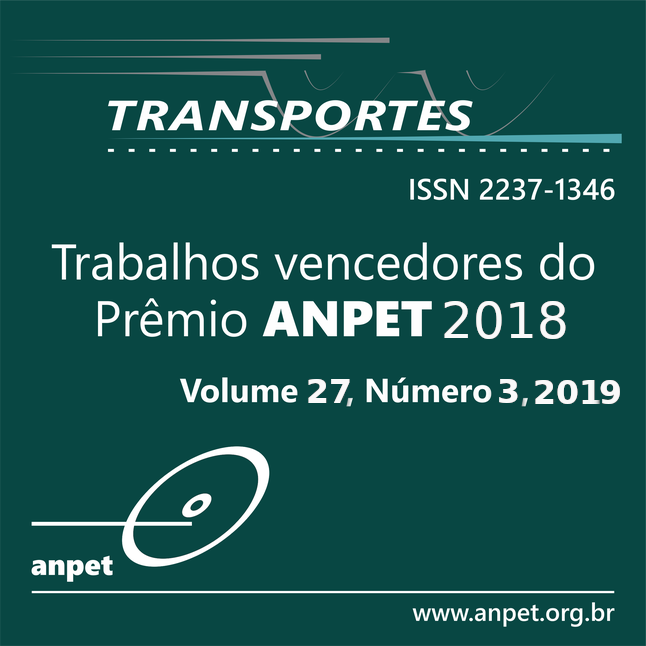Calibration of the VISSIM truck performance model using GPS data
DOI:
https://doi.org/10.14295/transportes.v27i3.2042Keywords:
Traffic stream simulation, VISSIM, GPS, Vehicular performance, Calibration of microsimulation models, Trucks.Abstract
Traffic simulators can be used to perform safe, low cost scenario evaluation. However, their mathematical models are calibrated to scenarios commonly found in the simulators’ country of origin. VISSIM truck acceleration functions were created for trucks with better power/mass ratios than typical Brazilian trucks. This paper presents the calibration of VISSIM truck acceleration functions using the difference between real and simulated speed profiles as goodness-of-fit measures. Using GPS, speed profiles were obtained for 57 trucks travelling over a segment of 18 km, four-lane freeway situated on rolling terrain, under low traffic flow. The calibration procedure was automated and based on a genetic algorithm. Several calibration runs were performed using different numbers of generations and population size. The resulting acceleration functions are presented and discussed.
Downloads
References
Balakrishna, R., C. Antoniou, M. Ben-Akiva, H. Koutsopoulos, and Y. Wen (2007). Calibration of microscopic traffic simulation models: Methods and application. Transportation Research Record: Journal of the Transportation Research Board, v. 1999, p. 198–207. DOI: 10.3141/1999-21.
Carvalho, L. G. S. and J. R. Setti (2017). Construção de perfis de velocidade de caminhões utilizando filtro gaussiano e regres-sões lineares em dados de GPS. In Anais do XXXI Congresso Nacional de Pesquisa em Transporte, ANPET, p. 3341–3352.
Chiappone, S.; O. Giuffrè; A. Granà; R. Mauro and A. Sferlazza (2016) Traffic simulation models calibration using speed–density relationship: An automated procedure based on genetic algorithm. Expert Systems with Applications, v. 44, p. 147-155, DOI:10.1016/j.eswa.2015.09.024.
Chu, L., H. X. Liu, J.-S. Oh, and W. Recker (2003). A calibration procedure for microscopic traffic simulation. In: Proc. of the 2003 IEEE International Conference on Intelligent Transportation Systems, Shanghai, China, v. 2, p. 1574–1579. DOI: 10.1109/ITSC.2003.1252749
Cunha, A. L., J. E. Bessa Jr., and J. R. Setti (2009). Genetic algorithm for the calibration of vehicle performance models of micro-scopic traffic simulators. In: Lopes L., N. Lau, P. Mariano, e L. Rocha (eds) Progress in Artificial Intelligence. EPIA 2009. Lec-ture Notes in Computer Science, v. 5816. Springer, Berlin, Heidelberg. DOI: 10.1007/978-3-642-04686-5_1
Cunha, A. L. B. N., M. M. Modotti, and J. R. Setti (2008). Classificação de caminhões através de agrupamento por análise de cluster. In Panorama Nacional da Pesquisa em Transportes 2008, Anais do XXII Congresso de Pesquisa e Ensino em Transpor-tes, ANPET, p. 1447–1459.
Egami, C. Y., J. R. Setti, and L. Rillet (2004). Algoritmo genético para calibração automática de um simulador de tráfego em rodovias de pista simples. Transportes, v. 12, n. 2, p. 5–14. DOI: 10.14295/transportes. v12i2.134
Heermann, D. W. (1990). Computer-Simulation Methods. Berlin, Heidelberg: Springer Berlin Heidelberg.
Hourdakis, J., P. Michalopoulos, and J. Kottommannil (2003). Practical procedure for calibrating microscopic traffic simulation models. Transportation Research Record: Journal of the Transportation Research Board, v. 1852, p. 130–139. DOI: 10.3141/1852-17
Jayakrishnan, R., J. Oh, and A. Sahraoui (2001). Calibration and path dynamics issues in microscopic simulation for advanced traffic management and information systems. Transportation Research Record: Journal of the Transportation Research Board, v. 1771, p. 9–17. DOI: 10.3141/1771-02
Kim, K. and L. R. Rilett (2001) Genetic algorithm based approach for calibration of microscopic simulation models. In: Proc. of the 2001 IEEE Intelligent Transportation Systems Conference, Oakland, CA, USA, p. 698–704. DOI:10.1109/ITSC.2001.948745
Kotusevski, G. and K. Hawick (2009). A review of traffic simulation software. Research Letters in the Information and Mathe-matical Sciences, v. 13, p. 35–54.
Li, J., H. J. Van Zuylen, and X. Xu (2015). Driving type categorizing and microscopic simulation model calibration. Transporta-tion Research Record: Journal of the Transportation Research Board, v. 2491, p. 53–60. DOI: 10.3141/2491-06
Ma, T. and Abdulhai, B. (2002) Genetic Algorithm-Based Optimization Approach and Generic Tool for Calibrating Traffic Mi-croscopic Simulation Parameters. Transportation Research Record: Journal of the Transportation Research Board, v. 1800, p. 6–15. DOI: 10.3141/1800-02
Medeiros, A., M. de Castro Neto, C. Loureiro, and J. E. Bessa Jr. (2013). Calibração de redes viárias urbanas microssimuladas com o uso de algoritmos genéticos. In: Anais do XXVII Congresso Nacional de Pesquisa em Transporte, ANPET.
Park, B. and H. Qi (2005). Development and evaluation of a procedure for the calibration of simulation models. Transporta-tion Research Record: Journal of the Transportation Research Board, v. 1934, p. 208–217. DOI: 10.1177/0361198105193400122
PTV (2016). PTV VISSIM 9 User Manual. Karlsruhe, Germany: PTV Planung Transport Verkehr AG.
Shumate, R. P. and J. R. Dirksen (1965). A simulation system for study of traffic flow behavior. Highway Research Record, v. 72, p. 19–39.
Toledo, T., M. Ben-Akiva, D. Darda, M. Jha, and H. Koutsopoulos (2004). Calibration of microscopic traffic simulation models with aggregate data. Transportation Research Record: Journal of the Transportation Research Board, v. 1876, p. 10–19. DOI: 10.3141/1876-02
Downloads
Published
How to Cite
Issue
Section
License
Authors who submit papers for publication by TRANSPORTES agree to the following terms:
- The authors retain the copyright and grant Transportes the right of first publication of the manuscript, without any financial charge, and waive any other remuneration for its publication by ANPET.
- Upon publication by Transportes, the manuscript is automatically licensed under the Creative Commons License CC BY 4.0 license. This license permits the work to be shared with proper attribution to the authors and its original publication in this journal.
- Authors are authorized to enter into additional separate contracts for the non-exclusive distribution of the version of the manuscript published in this journal (e.g., publishing in an institutional repository or as a book chapter), with recognition of the initial publication in this journal, provided that such a contract does not imply an endorsement of the content of the manuscript or the new medium by ANPET.
- Authors are permitted and encouraged to publish and distribute their work online (e.g., in institutional repositories or on their personal websites) after the editorial process is complete. As Transportes provides open access to all published issues, authors are encouraged to use links to the DOI of their article in these cases.
- Authors guarantee that they have obtained the necessary authorization from their employers for the transfer of rights under this agreement, if these employers hold any copyright over the manuscript. Additionally, authors assume all responsibility for any copyright infringements by these employers, releasing ANPET and Transportes from any responsibility in this regard.
- Authors assume full responsibility for the content of the manuscript, including the necessary and appropriate authorizations for the disclosure of collected data and obtained results, releasing ANPET and Transportes from any responsibility in this regard.









